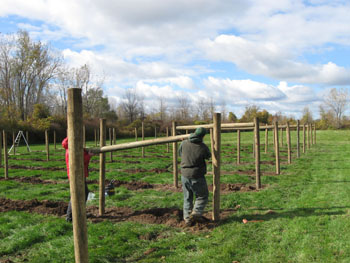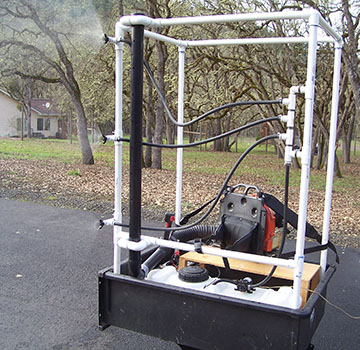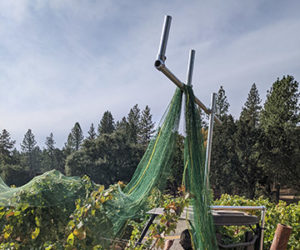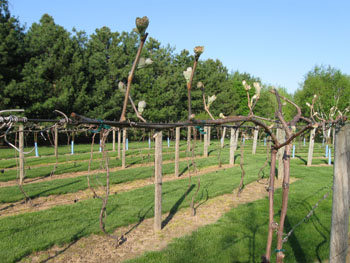 There are several options available to a backyard grape grower when considering which trellis configuration and which training system to use. How do we focus on what’s important in a trellis and training system and avoid getting caught up in the mire? Let’s look at the basic requirements and select a trellis system that has practical trellis design and installation parameters for the backyard grape grower. I have a favorite recommendation for a backyard trellis . . . I will give you my perspective on which one and why later.
There are several options available to a backyard grape grower when considering which trellis configuration and which training system to use. How do we focus on what’s important in a trellis and training system and avoid getting caught up in the mire? Let’s look at the basic requirements and select a trellis system that has practical trellis design and installation parameters for the backyard grape grower. I have a favorite recommendation for a backyard trellis . . . I will give you my perspective on which one and why later.
Why we need a trellis:
Grapes naturally grow up towards the sun, competing with and using fellow plants and trees to elbow their way up to the sunlight. A grapevine is perfectly happy hanging around a treetop, stealing the available sunlight, and producing sweet grapes up high. The birds and other critters will relocate the seeds, ensuring that the grapevines will exist in the future. Mission accomplished.
Now we grape loving humans come along and see that it’s not very easy to harvest grapes from the treetops. A better idea is to control these far reaching vines in an attempt to maximize their performance and make it easier for us to harvest the fruit.
The way to maximize the performance of a grapevine is to balance the amount of fruit development with the amount of energy-producing parts of the vine (leaves). Having too much fruit without having enough energy-producing leaves will result in an imbalance. This imbalance creates an environment in which the grapes cannot fully ripen and the vine is stressed by trying to provide all the grapes with sufficient energy, even though it cannot. The vines will allocate some of the energy to the fruit instead of retaining sufficient energy for overwintering and for use during the following spring.
We also would like to configure our grape vine such that the fruit is somewhat exposed to the sun and wind. We don’t want too many leaves creating a canopy that is thick and crowded, creating pockets that trap moisture. An open canopy facilitates fruit ripening by sun exposure, drying of the grapes and leaves quickly after a rain or dew event, and allows good pesticide coverage on the fruit and leaves opposed to just spraying the outside of the canopy.
We need to retain the appropriate number of buds such that we optimize the fruit production and canopy leaf density. Retaining too many buds results in over cropping and an excessively thick canopy that blocks the sun and wind. Over cropping will impair the fruit development and stress out the vines. An excessively thick canopy will promote mildews and other diseases, and also negatively affect grape ripening. A thick canopy also makes it more difficult to harvest in the fall and to prune in the spring. The experts have determined that 4- 7 buds per linear foot of canopy is a good approximation to use when pruning to create a crop load and canopy that are in balance.
In a paper titled “Shoot density and Canopy Management for Hybrids,” Tim Martinson (Senior Extension Associate) and Justine Vanden Heuvel (Assistant Professor) from Cornell University wrote: “Aim for 4-7 shoots per linear foot of canopy (if canopy is vertically or horizontally divided, that’s 4-7 shoots for each portion of a divided canopy), and remove secondary buds where both primaries and secondaries have pushed. The result will be a more open canopy, less leaf layers, better fruit exposure – and hopefully more intense flavors and fewer ‘unripe’ flavors in your wines.” This same paper cites the optimal vinifera shoot density as 4–6 shoots per foot. You can read the paper at: http://www.fruit.cornell.edu/grape/pdfs/Canopy%20Management%20for%20Hybrids%20-2007.pdf
“Rules of Thumb” Regarding Trellis and Training Selection, Implementation, and Maintenance:
• 6 buds per foot (30 cm) is the target linear density for our canopy.
• Internode spacing (space between buds) is 4 inches (10 cm) — about the width of a closed fist.
• Vinifera vines will be planted with 6-foot (1.8-m) spacing.
• Hybrid vines will be planted with 8-foot (2.4-m) spacing because of their typical high vigor.
• Row orientation will be North-South (if practical) to allow sun exposure on the east side of the canopy in the morning, and on the west side of the canopy in the evening.
• Row spacing will be 10 feet (3 m). The row spacing is between the canopy wires in adjacent rows opposed to between the posts in adjacent rows. This wire to wire spacing is important to take into consideration with a double canopy such as the Geneva Double Curtain.
• Double trunks or quad trunks are good practices in colder climates. Retaining multiple trunks is an insurance policy for split trunks that can occur in cold climates. Multiple trunks can also develop more options for spring cane selection in the renewal zone.
• Using angled end posts is a less expensive choice, but using H-Braces for the end posts will eliminate the unsightly wires that run from the end post to an earth anchor. These earth anchor wires also create a trip hazard in a backyard vineyard.
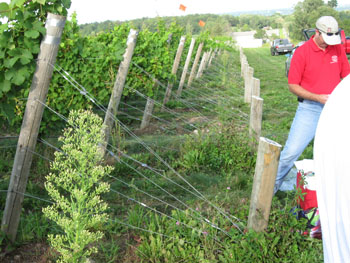
Four Basic Vine Training Options:
Bilateral Canes:
One fruiting wire with one cane trained to the right from the trunk and one cane trained to the left from the trunk.
Each Vinifera cane will be ~3 feet (0.9 m) long. That will give us 72 inches (1.8 m) of canes on our fruiting wire. With 4-inch (10-cm) bud spacing, that will give us 72/4 = 18 buds in 6 feet (1.8 m) of canopy or 3 buds per foot. Not as dense as our goal of 6 buds per foot.
Each Hybrid cane will be ~4 feet (1.2 m) long. That will give us 96 inches (2.4 m) of canes on our fruiting wire. With 4-inch (10-cm) bud spacing, that will give us 96/4 = 24 buds in 8 feet (2.4 m) of canopy or 3 buds per foot. Again, this bud density is only half as dense as our goal of 6 buds per foot.
Quadrilateral Canes:
Two fruiting wires. Each fruiting wire has one cane trained right from the trunk and one cane trained left from the trunk. Without doing redundant math, we can easily see that our bud linear density will be double that of a bilateral cane system, or 6 buds per linear foot. That is exactly our target bud density.
Bilateral Cordons with Spurs:
One fruiting wire. Each fruiting wire has one cordon trained to the right from the trunk and one cordon trained to the left from the trunk. Ideally we would have a spur every 4 inches (10 cm). If we retain two buds per spur, our bud density will be 2 buds x 3 spurs per foot = 6 buds per linear foot, which is our target. This will be true with vinifera at 6-foot (1.8-m) spacing and with hybrids at 8-foot (2.4-m) spacing. In practicality, getting spurs exactly every 4 inches (10 cm) may be hit or miss, so extra buds can be retained if the spur spacing is more than 4 inches (10 cm).
Quadrilateral Cordons with Spurs:
Two fruiting wires. Each fruiting wire has one cordon trained right from the trunk and one cane trained left from the trunk. Again without doing redundant math, we can see that our bud linear density will be double that of a bilateral cane system, or 12 buds per linear foot of row. Quadrilateral cordons are usually implemented on a double canopy (aka double curtain) trellis system, so the 6 buds per linear foot of canopy will still be achieved.
The decision to cane prune or spur prune can be a personal choice, or it may be a choice that is influenced by the winter damage. For example, I like cane pruning because I usually get much more symmetrical bud spacing. When I use spur pruning, the cordons frequently have spots along the cordon that don’t produce new canes, or some of last year’s wood was destroyed over the winter. I don’t always have the opportunity to have a cordon with viable spurs that will reach all the way to the next vine. In this case I may use spur pruning for the first foot of cordon or so, and then lay a short cane down from the last cordon node to fill out the wire to the adjacent vine.
Trellis Wire Configurations and Training the Vines to those Wires:
Now that we have looked at four basic training systems, let’s look at which trellis wire configurations can be used with each of these training systems. There are numerous trellis and training systems available to the grape grower, but for simplicity in this discussion we will select five that are commonly used. We will consider Top Wire Cordon (TWC), Geneva Double Curtain (GDC), Vertical Shoot Positioning (VSP), Four Arm Kniffin (FAK), and the Umbrella Kniffin (UK). TWC, GDC, and VSP are commonly used acronyms in the grape growing industry. FAK and UK are not acronyms that are frequently used, but we will use them during this discussion.
Quadrilateral Canes are usually implemented on VSP, FAK, and UK. Bilateral cordons are usually implemented on TWC and Quadrilateral Cordons are used with GDC. The GDC is actually a double canopy so each canopy is bilateral cordon.
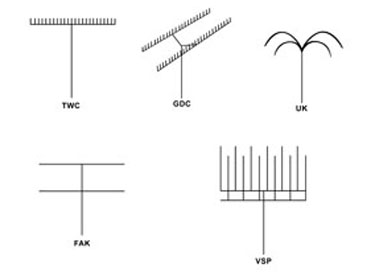
The FAK, UK, and TWC can all be implemented on an inexpensive three-wire trellis system. The three-wire trellis is implemented with the wires at various heights, but a typical example is where the bottom wire is placed approximately 30 inches (76 cm) from the ground, the top wire placed at the top of the post, and the other wire in-between the top and bottom wires.

The following links will take you to videos that show the five training systems:
FAK http://www.youtube.com/watch?v=0-XQ_ukRMFA
UK http://www.youtube.com/watch?v=ApcQOp-IEgk
TWC http://www.youtube.com/watch?v=-ZvaReI5vr4
GDC http://www.youtube.com/watch?v=GPE7UICamgg
VSP http://www.youtube.com/watch?v=qqfItnOQBjc
Advantages and Disadvantages of These Trellis and Training Systems:
Four Arm Kniffin
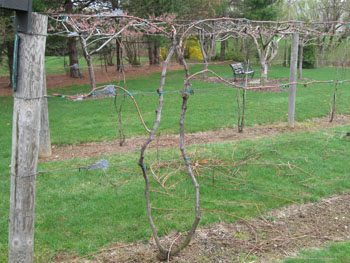
The Umbrella Kniffin
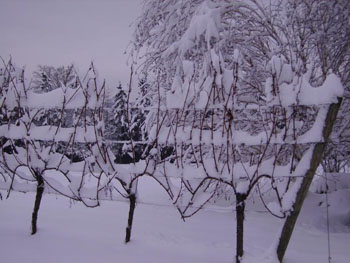
The UK is implemented by tying the trunk to the bottom wire and developing the renewal spur zone at the second wire or just below the top wire. Either a bilateral cane system or a quadrilateral cane system is implemented. The canes start in the spur renewal zone by the second wire, and then are draped over the top wire and tied down at the second wire, forming arches on both sides of the trunk. The UK allows more buds to be retained because an arched cane is longer than a cane that is laid flat on a single wire. The UK is still widely used but I don’t recommend it for a new installation. I think you can achieve better linear bud density by using quadrilateral canes in a VSP system. A variation of the UK system is to have the spur renewal zone low in the trellis and then have catch wire pairs to allow vertical shoot positioning.
Top Wire Cordon
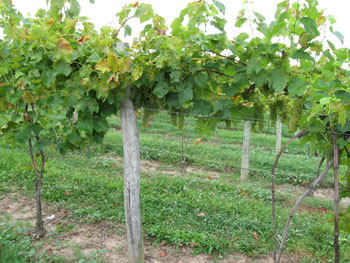
Geneva Double Curtain

The GDC system uses some variation of a T-bracket at the top of the post. The T-bracket will have a wire at each end of the T, a wire about a foot from the top of the posts, and another trunk wire approximately 30 inches (76 cm) from the ground. The advantage of using the GDC Trellis and training system is that it provides more canopy area for highly vigorous, downward growing cultivars. You can see in the previous illustration of fruiting zones that the GDC system is basically two TWC systems from one vine. Leaf pulling can be more difficult because access to both sides of the canopies is somewhat restricted as compared to the TWC. Installing and removing bird netting can also be more complicated with GDC than it is for TWC. I know backyard growers that are successful using the GDC system. Double curtain systems usually increase your yield per square foot of vineyard. I don’t strongly recommend a GDC system for a new backyard vineyard for the same reasons I don’t strongly recommend a TWC system. I prefer to use canes over cordons, and I like a more easily controlled canopy with a manicured look. I would not discourage anyone from using GDC if they really like the system, but it’s just not my favorite.
Vertical Shoot Positioning
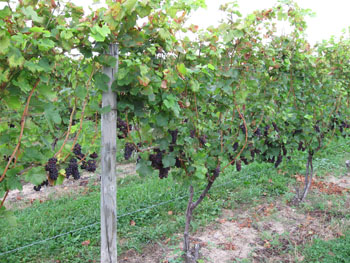
I have installed the 9-wire VSP system for several clients. I have trained several cultivars including Corot Noir, Traminette, and Noiret on this 9-wire VSP and had excellent results. All three of these cultivars are described as having a “semi upright” growth habit in the Double A Vineyards “Grapevine Variety Characteristic Chart”. You can view this excellent vine characteristic chart here: https://www.doubleavineyards.com/Images/Grapevine%20Characteristic%20Chart.pdf
The 9-wire VSP trellis and training system is also successfully used throughout the Finger Lakes with vinifera vines that are categorized as having “upright” growth habits.
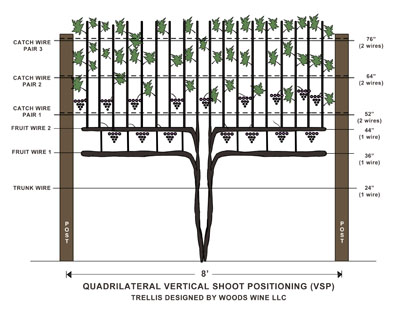
The figure above 6.5 feet (2 m) of post above ground where 10-foot (3-m) post were used. You could reduce cost if you use 8-foot (2.4 m) posts with 6 feet (1.8 m) above ground and position the wires 6 inches (15 cm) lower than shown in this figure. Using 10-foot (3-m) posts makes a very sturdy trellis system that will last a long time without the posts heaving or leaning. If you can afford them, I would recommend using 10-foot (3-m) posts a diameter of 4-5 inches (10-13 cm) throughout the vineyard. The best vineyard I have ever installed has 10-foot (3-m) posts pounded in the ground 3.5 feet (1 m), leaving 6.5 feet (2 m) above ground. This is how the trellis shown in this figure was installed. For free online trellis installation resources, check out the “Links” page on my website: WoodsWine.com.
When installing your trellis system, don’t skimp on materials. The trellis is like the foundation of a house. The house is only as strong as the foundation it is built on. A vineyard is only as strong as the trellis you build for it. Use real vineyard posts of high quality, not 4-by-4s. I prefer wooden posts because of their esthetic appeal. I recommend H-braces opposed to angled end posts with guy wires tied to earth anchors. It is also advantageous to spend the extra money up front and put additional wires on. I’m referring to the value of the 9-wire VSP system opposed to the inexpensive three-wire trellis. Wire and staples are relatively inexpensive. The benefit of having three sets of catch wires to tuck your shoot into is well worth the money. The additional bud retention facilitated by having two fruiting wires will give you higher yields than a single fruiting wire. The trunk wire is useful for tying the grow tubes on newly planted vines, for securing the trunk, and for securing side netting.
For additional reading, I recommend a presentation created by Dr. Duke Elsner of MSU Extension in Traverse City, Michigan titled “Trellis Systems vs. Varieties vs. Management: Pros & Cons & Ideas from Michigan.” Here is the link: http://viticulture.hort.iastate.edu/info/07iawgamtg/trainingsystemselsner.pdf
Conclusion
As you can see, there are several viable options available for a backyard vineyard trellis and training system. I have only touched on a few. There are several very successful backyard vineyards that employ different types of trellis and training systems. I have seen both TWC and GDC quite often used for downward growth tendency vines, and many hobby growers are happy with the results. In my experience though, I find that the 9-wire VSP quadrilateral cane system stands out because it has so many advantages for both vinifera and hybrids. This VSP trellis is more expensive to install, and worth every penny of additional cost. It is very difficult to modify an existing trellis once you have mature vines in place, so get it right the first time. Build a good foundation for your new vineyard, and it will make you happy for the next 20 years!


